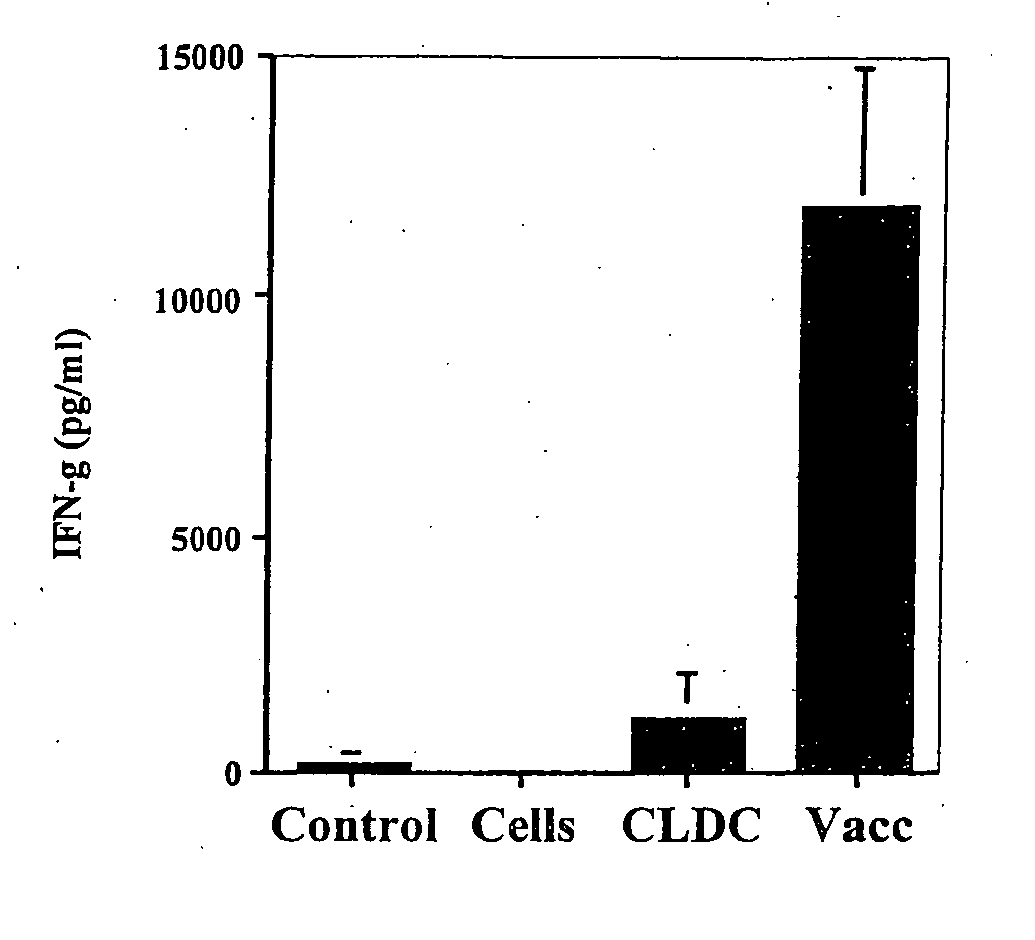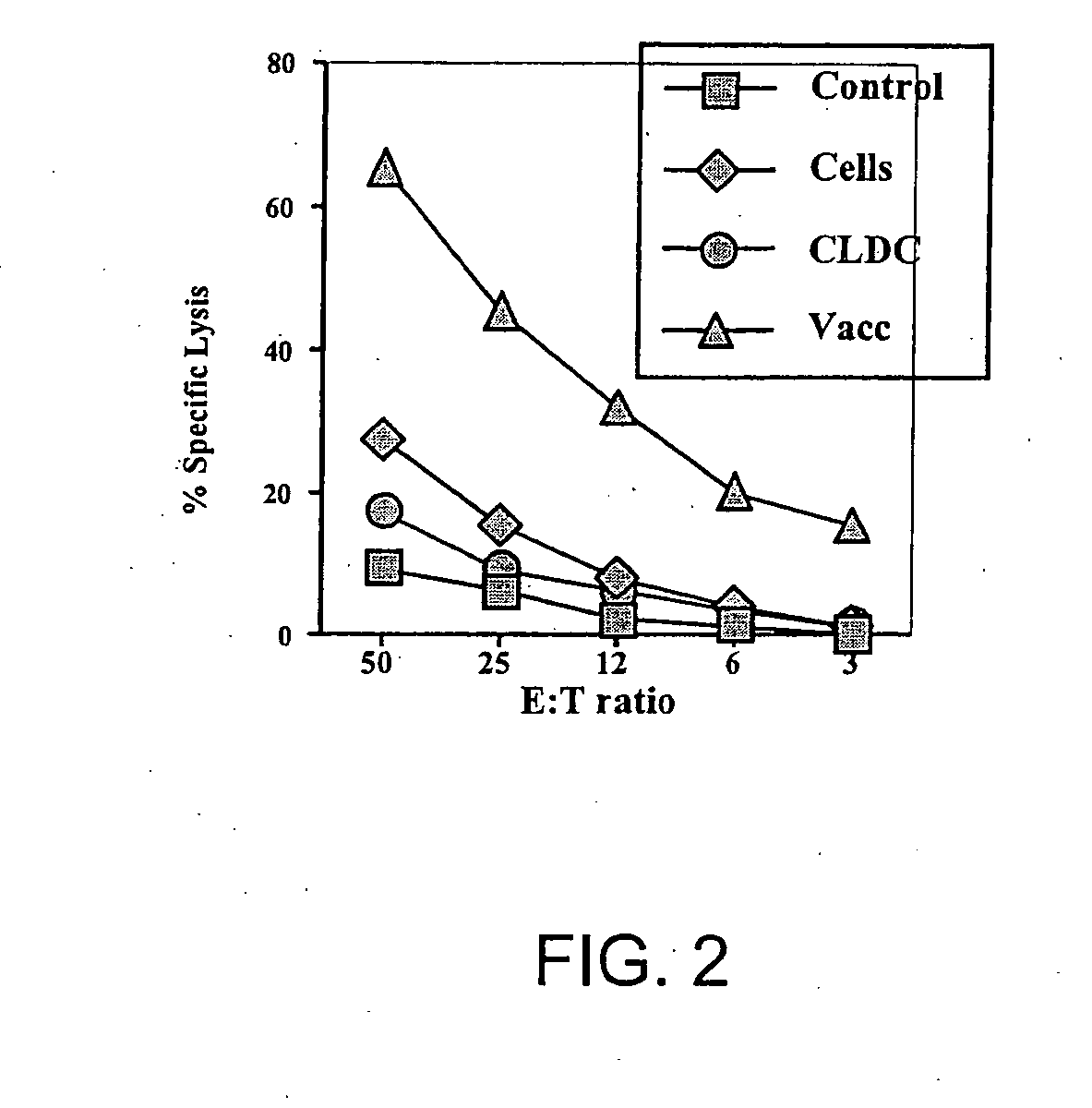Vaccines using nucleic acid-lipid complexes
a nucleic acid and lipid complex technology, applied in the field of vaccines using nucleic acidlipid complexes, can solve the problems of tissue damage and sometimes death, unwanted side effects, and disrupting the replication of normal cells in the treated patient,
- Summary
- Abstract
- Description
- Claims
- Application Information
AI Technical Summary
Benefits of technology
Problems solved by technology
Method used
Image
Examples
example 1
[0112] The following example shows that immunization with cationic lipid-DNA complexes combined with tumor lysates generates antitumor immunity.
[0113] The ability of cationic lipid-DNA complexes (CLDC) to enhance the effectiveness of vaccination with tumor antigens was assessed in BALB / c mice using the syngeneic CT26 tumor cell line. The cationic lipid-DNA complexes were prepared using DOTIM and cholesterol liposomes and empty vector (EV; non-coding) plasmid DNA. The tumor cell vaccine consisted of lysates of CT26 tumor cells, which were prepared by first incubating live tumor cells in vitro with EV / CLDC for 30 minutes, then subjecting the cells to 4 freeze-thaw cycles. The tumor lysate solution was then added to 1 ml of pre-formed EV / CLDC to prepare lipid-antigen-DNA complexes (LADC), where the antigen was comprised of tumor cell lysates. Control tumor cell lysates were prepared by freeze-thaw of tumor cells without addition of any EV / CLDC. BALB / c mice (4 per group) were immunized...
example 2
[0115] The following example demonstrates that immunization with a CLDC plus tumor lysates elicits high levels of cytotoxic T lymphocyte (CTL) activity.
[0116] The effect of tumor vaccination on tumor-specific cytotoxic T lymphocyte activity (CTL) was assessed using BALB / c mice and the CT26 tumor line, as described in Example 1 above. BALB / c mice (4 per group) were immunized twice with either tumor lysates only (“cells”), with EV / CLDC only (“CLDC”), or with tumor lysates plus CLDC (“Vacc”). Untreated mice served as controls. One week after the second immunization, spleen cells were harvested and re-stimulated in vitro for 5 days using irradiated CT26 cells. On day 5, cytotoxic activity of the-effector T cells was assessed using CT26 51Cr-labeled target cells. As shown in FIG. 2, vaccination with tumor lysates plus CLDC elicited much greater levels of CTL activity against autologous tumor cells than immunization with either tumor lysates alone or CLDC alone.
example 3
[0117] The following example demonstrates that immunization with tumor lysates combined with CLDC elicits lymphocyte proliferative activity.
[0118] BALB / c mice were immunized with either CT26 tumor lysates alone (“cells”), CLDC alone, or tumor lysates plus CLDC (“Vacc”), as described in Example 1. One week after a booster vaccination, spleen cells were harvested and incubated with tumor cell lysates for 3 days. The proliferative response was assessed by pulsing with 3 H thymidine for 18 h. The mean proliferative response (±SE) was then plotted. Immunization with tumor lysates plus CLDC elicited significantly greater proliferative responses than immunization with tumor lysates alone. These results and the results from Example 2 (FIG. 2) indicate that a tumor vaccine prepared using tumor lysates combined with CLDC is capable of eliciting both CD4+ T cell responses (proliferation) and CD8+ T cell responses (CTL activity).
PUM
| Property | Measurement | Unit |
|---|---|---|
| Fraction | aaaaa | aaaaa |
| Ratio | aaaaa | aaaaa |
| Pharmaceutically acceptable | aaaaa | aaaaa |
Abstract
Description
Claims
Application Information
 Login to View More
Login to View More - R&D
- Intellectual Property
- Life Sciences
- Materials
- Tech Scout
- Unparalleled Data Quality
- Higher Quality Content
- 60% Fewer Hallucinations
Browse by: Latest US Patents, China's latest patents, Technical Efficacy Thesaurus, Application Domain, Technology Topic, Popular Technical Reports.
© 2025 PatSnap. All rights reserved.Legal|Privacy policy|Modern Slavery Act Transparency Statement|Sitemap|About US| Contact US: help@patsnap.com



